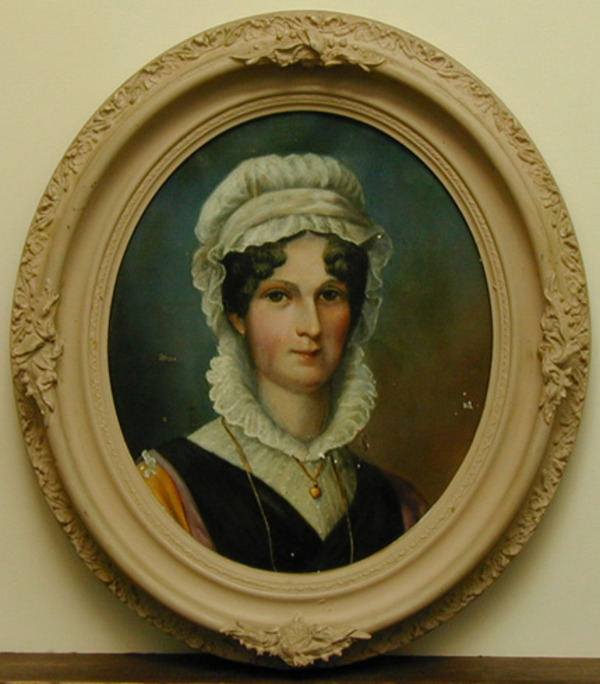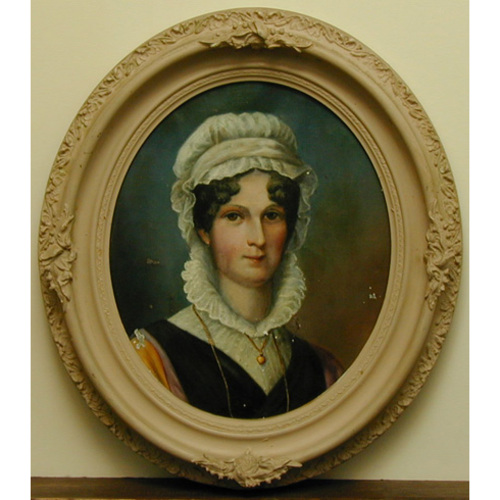
Source: Link
DELEZENNE, MARIE-CATHERINE (Pélissier; Sales Laterrière), b. 26 March 1755 at Quebec, daughter (the third christened Marie-Catherine) of Ignace-François Delezenne*, a silversmith, and Marie-Catherine Janson, dit Lapalme; d. 3 May 1831 in Les Éboulements, Lower Canada, and was buried there three days later.
Marie-Catherine Delezenne is remembered because of her love affair with Pierre de Sales* Laterrière. She began seeing him after he moved to Quebec in 1771 and they quickly fell in love. Notwithstanding this attachment, and despite her “refusals, tears, wailings,” Marie-Catherine at the age of 19 was forced to marry a 46-year-old widower, Christophe Pélissier*. Pélissier was a friend of her father, director of the Saint-Maurice ironworks, and “a very rich man, from whom [her parents] were hoping to receive substantial assistance.” The marriage took place in secret at Bécancour on 8 March 1775, at night, with the connivance of the ecclesiastical authorities and of “people who had been bribed.”
Marie-Catherine was immediately taken to the ironworks. Laterrière later told the story: “She nearly went mad there, not believing that she was married to Pélissier and not wishing to remain with him. The father and this husband tried by every means to calm her. Frightened, afraid of losing her, feeling that only my presence would do her good and that there was no other solution, Pélissier called me to the ironworks; that was how I got the job as inspector there. . . . Only my presence calmed her and made her put up with her misfortune, [or] at least kept her from causing some sort of scandal. If I got up at the crack of dawn, I invariably found her at the doorway; a kiss sealed our never-ending promises and resolves to love each other until death!” Pélissier’s abrupt departure with the Americans on 7 June 1776 left the field open to the lovers: “We gave way to our inclination, and the fruit of so much love was a pregnancy that resulted in the birth of our dear Dorothée on 4 Jan. 1778.” They took up residence at Bécancour, where they lived “a quiet and happy life.” But because of her illegitimate birth Dorothée would not be baptized until she was 16.
In the summer of 1777 Pélissier, who was then in Lyons, had given orders for his wife to be sent to France. Naturally Marie-Catherine had refused to go. On the other hand, a power of attorney from her husband had enabled her to play a role in transferring the lease to the Saint-Maurice ironworks, which was shifted from Pélissier to Alexandre Dumas* through the agency of Ignace-François Delezenne. Pélissier came back to Quebec in the summer of 1778. While he was working with Laterrière on the accounts of the ironworks, some ruffians in his employ carried off Marie-Catherine, who was then confined to the home of silversmith François Ranvoyzé*. They tried to make her sign a statement that Laterrière had raped her. The document, they said, would set her free. In fact it would have enabled Pélissier to get her back as his wife and to take legal action against Laterrière. Marie-Catherine, however, did not consent to signing this “foul” declaration. An astute woman, she succeeded in slipping away and reached Île de Bécancour. Under Pélissier’s instructions her parents went after her. She escaped them by hiding in various places, including a secret room set up in a barn in among bundles of hay.
Pélissier went off again to Europe, empty-handed, in September 1778. On 1 November in the presence of witnesses Marie-Catherine and Laterrière signed what can be interpreted as a private marriage contract, a document they took the precaution of having recorded subsequently in the register of notary Charles-Louis Maillet, at the same time sending a copy to Marie-Catherine’s parents. The stinging rejoinder took the form of a virtual excommunication pronounced by Bishop Jean-Olivier Briand* on 12 November. But this did not suffice to separate the “adulterous concubinaries.” Pélissier started working on his friend Governor Frederick Haldimand*, mounting a skilful campaign to defame Laterrière by making him appear to have collaborated with the Americans, even though he was by his own account basically a royalist. Ignace-François Delezenne was also drawn into conspiring against Laterrière, using as a basis some false testimony proferred by Delezenne’s son Michel-Mathieu. Laterrière was wrongfully charged with treason, imprisoned in March 1779, then stripped of his property by profiteers. Predictably, with her lover in prison Marie-Catherine was still being detained at her parents’ home in July 1779. All her clothes had been seized along with Laterrière’s belongings and had not yet been given back despite her complaints to Haldimand. Consequently it was impossible for her, “lacking them, to go out.”
In the autumn of 1780 the conditions of Laterrière’s detention improved, thanks to the “silver key” that “opens many doors.” Marie-Catherine, who was living with her daughter in a house at Quebec purchased by her lover, was able to see him every day and even spend the night with him regularly. Therefore, though he was in prison, Laterrière succeeded in taking Marie-Catherine away from her parents, thus depriving them of the allowance being paid them by Pélissier. This situation prompted Delezenne and his wife to draw up a deed of disinheritance on 4 Nov. 1780. In it they declared that their daughter had “indulged in an excess of dreadful debauchery” and “prostituted herself in the vain hope of marriage with Jean-Pierre Laterrière”; that they “have done everything that nature and fatherly affection can suggest, . . . to the point of having the offer made her of returning to their home . . . ; that to urge her further to cease a life of vice they have even offered to take care of the child that their aforesaid daughter has had with the aforesaid Laterrière.” Invoking the laws, ordinances, and “nature itself,” they therefore barred their daughter from all rights of succession.
In 1782 Laterrière was freed, on condition that he go into exile until peace had returned. He had only 24 hours to get ready. Whether through bad luck or by someone’s design, Marie-Catherine was visiting her parents in Trois-Rivières at the time. Laterrière took refuge with Dorothée in Newfoundland. Marie-Catherine consequently had to wait until the spring of 1783 to be reunited with them at Quebec. Then, with her daughter and her brother Michel-Mathieu she went to live at Saint-Pierre-les-Becquets (Les Becquets), where she ran a small store, and where Laterrière came “to see her very often.” He, Marie-Catherine, and Dorothée soon moved to Bécancour, and then from the spring of 1784 they lived for five years in Gentilly (Bécancour). In 1784 the Delezennes also moved to the same region, to Baie-du-Febvre (Baieville), just after renewing the deed disinheriting Marie-Catherine. Finally, faced with the unshakeable determination of the couple, they retreated from their stand. Mme Delezenne died in Laterrière’s arms in November 1787, “happy,” and he recalled, “commending to my care her daughter, her husband, and all her children.” And when Laterrière went to Boston to study, Marie-Catherine went to live with her father on a property that he had just made over to her. The fond grandfather became so attached to his grandson Pierre-Jean that he “never left him for an instant,” according to Laterrière’s memoirs.
Shortly after Delezenne’s death in 1790 Marie-Catherine settled in Trois-Rivières with Laterrière. They had to wait a number of years, however, before they could make their union legal, a step they were finally able to take at Quebec on 10 Oct. 1799, after obtaining Pélissier’s death certificate. They could then enjoy a privileged rank in society befitting their improved fortunes. Their daughter Dorothée, however, made an unhappy marriage that ended in separation from bed and board, since “those who are in authority in this matter refuse to allow divorce in this country.” One of their sons died in a tragic accident. Pierre de Sales Laterrière, who had become the seigneur of Les Éboulements, died at Quebec on 14 June 1815. Marie-Catherine survived him by many years; “after an illness lasting two years and two months,” she died at Les Éboulements in 1831 at the age of 76. Since 1829 the entire seigneury had been in the hands of her son Marc-Pascal*.
It was only through her exceptional strength of character that Marie-Catherine Delezenne had been able to face and overcome the enormous social pressures exerted to make her, against feeling, taste, and personal choice, “return to the straight and narrow path.” Her struggle was exemplary in this respect, and in it there was the germ of a fight for the recognition of the rights and liberties of women as full partners in Canadian society. The role she played therefore confers upon her a prominent place in the defence of the ideals of personal liberty, tolerance, and respect for the fundamental rights of the individual.
The descendants of the Laterrière family possess a portrait of Marie-Catherine Delezenne as well as the manuscript copy of Pierre de Sales Laterrière’s memoirs. The diploma he received in 1789 from Harvard College and his licence to practise medicine in the province of Quebec were given to the Arch. de l’univ. Laval by his great-grandson Edmond de Sales Laterrière, a notary at Les Éboulements (Que.). The deed of gift was notarized by Lavery Sirois of Quebec and three copies were issued. Sirois’s minute-book was entrusted to his son, Joseph Sirois, a notary in Quebec.
AAQ, 12 A, G: f.21v; 20 A, I: 181; 210 A, VII: f.192. ANQ-MBF, CN1-5, 24 sept. 1778; 10 févr. 1779; 5 sept., 4 nov. 1780; 15 oct., 6 déc. 1783; 12 mars 1787; 27 sept. 1788; 16 sept. 1790; 5 févr., 26 nov. 1793; CN1-64, 11 juill. 1777; 12 févr., 22 juin, 6, 23 oct., 1er nov. 1778; 25 févr., 29 mars, 15 sept. 1779. ANQ-Q, CE1-1, 26 mars 1755, 10 oct. 1799; P-597. AP, Saint-Antoine-de-Padoue (Baieville, Qué.), Reg. des baptêmes, mariages et sépultures, 14 nov. 1787; 1er juill. 1789; 1er, 2 mai 1790; 25 mars 1792; 20 févr. 1794. Arch. de l’univ. Laval (Québec), 298/17. ASQ, C 36: 180; Séminaire, 70, no.62. BL, Add. mss 21681/2, 21845 (copies at PAC). “Collection Haldimand,” PAC Rapport, 1888: 984–88, 994. Pierre Du Calvet, Appel à la justice de l’État; ou recueil de lettres au roi, au prince de Galles, et aux ministres; avec une lettre à messieurs les Canadiens, . . . une lettre au général Haldimand lui-même; enfin, une dernière lettre à milord Sidney . . . (Londres, 1784), 151–52. Pierre de Sales Laterrière, Mémoires de Pierre de Sales Laterrière et de ses traverses, [Alfred Garneau, édit.] (Québec, 1873; réimpr. Ottawa, 1980). L’Observateur (Montréal), 21 mai 1831. Quebec Gazette, 6 Aug. 1778, 5 Jan. 1792. Caron, “Inv. de la corr. de Mgr Briand,” ANQ Rapport, 1929–30: 119; “Inv. de la corr. de Mgr Denaut,” 1931–32: 159; “Inv. de la corr. de Mgr Plessis,” 1927–28: 277. P.-G. Roy, Inv. concessions, 3: 246. Tanguay, Dictionnaire. Yvon Thériault, “Inventaire sommaire des Archives du séminaire des Trois-Rivières,” ANQ Rapport, 1961–64: 93. H.-R. Casgrain, La famille de Sales Laterrière (Québec, 1870). Robert Derome, “Delezenne, les orfèvres, l’orfèvrerie, 1740–1790” (thèse de
Cite This Article
Robert Derome, “DELEZENNE, MARIE-CATHERINE (Pélissier; Sales Laterrière),” in Dictionary of Canadian Biography, vol. 6, University of Toronto/Université Laval, 2003–, accessed April 28, 2025, https://www.biographi.ca/en/bio/delezenne_marie_catherine_6E.html.
The citation above shows the format for footnotes and endnotes according to the Chicago manual of style (16th edition). Information to be used in other citation formats:
| Permalink: | https://www.biographi.ca/en/bio/delezenne_marie_catherine_6E.html |
| Author of Article: | Robert Derome |
| Title of Article: | DELEZENNE, MARIE-CATHERINE (Pélissier; Sales Laterrière) |
| Publication Name: | Dictionary of Canadian Biography, vol. 6 |
| Publisher: | University of Toronto/Université Laval |
| Year of revision: | 1987 |
| Access Date: | April 28, 2025 |



